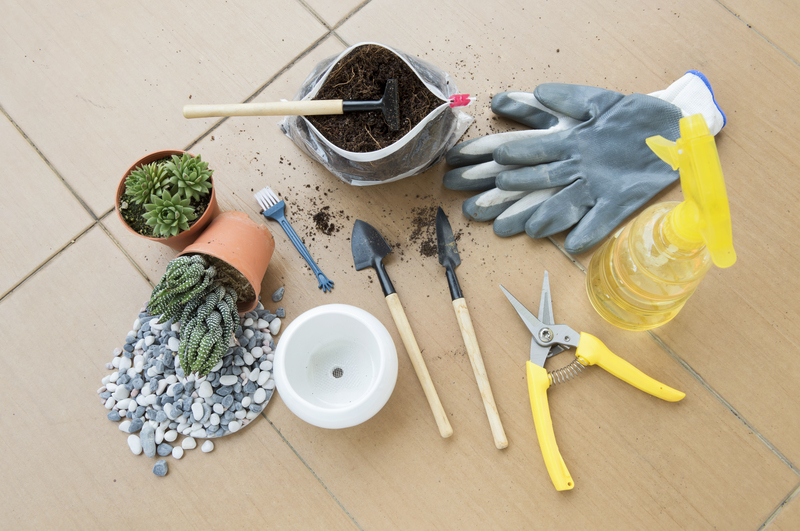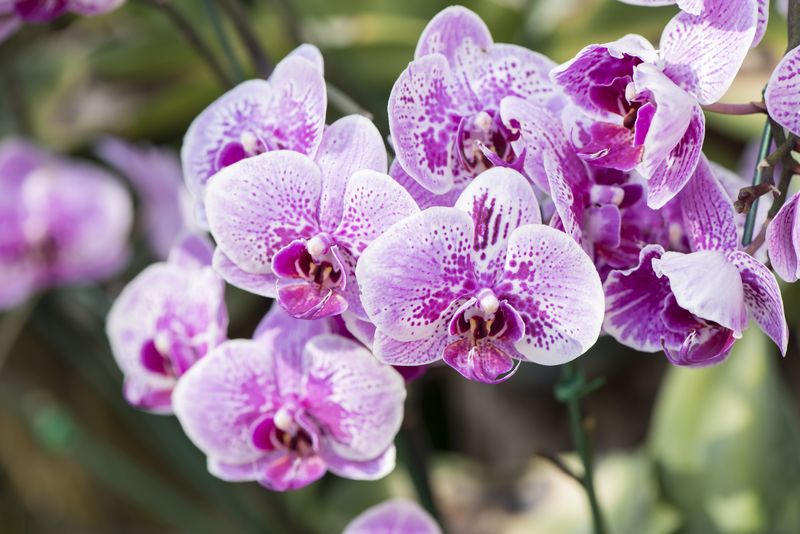Vertical Gardening: Growing Upward, Not Outward
Posted on 07/10/2025
Vertical gardening is transforming the way people around the world approach home and urban gardening. By growing plants upward on walls, trellises, or specialized structures, rather than outward on flat plots, vertical gardeners save space, increase yield, and add visual appeal. Whether you're a city dweller with a small balcony or a homeowner seeking to maximize your yard, learning the principles of gardening up instead of out can revolutionize your gardening experience.
What is Vertical Gardening?
Vertical gardening is a method of cultivating plants on a vertical surface, such as a wall, fence, or free-standing frame. It optimizes both horizontal and vertical space, creating lush, living walls and *towering planters* that are as attractive as they are productive.
- Uses less ground space than traditional gardens
- Offers creative design possibilities
- Brings greenery to patios, balconies, and tiny yards
- Helps urban gardeners raise more crops in limited environments
- Can be done indoors or outdoors
From herbs and vegetables to flowering vines and succulents, vertical gardens can support a remarkable variety of plants. This gardening method has become especially popular in urban areas, where space is at a premium and the desire for fresh produce and beautiful foliage remains strong.

Benefits of Growing Upward
Why choose vertical gardening? The advantages go well beyond saving space:
1. Space Optimization
The clearest benefit of vertical gardens is their ability to maximize limited growing space. Rather than spreading out, you grow upward, making it possible to enjoy a large garden's bounty--even in a tiny apartment or backyard.
2. Improved Air Quality
Vertical gardens act as natural air filters, helping to absorb carbon dioxide, trap dust, and even reduce noise pollution. Living walls indoors can dramatically improve air quality and humidity, benefiting your overall health.
3. Pest and Disease Control
Elevating your plants helps limit exposure to certain soil-borne pests and diseases. Vertical gardening creates better airflow, making it harder for fungal infections to spread and keeping leafy greens or delicate flowers dry and healthy.
4. Easier Maintenance
By raising plants to eye level, vertical gardening reduces the need to bend or kneel when watering, harvesting, or pruning. This makes garden maintenance more convenient and can be especially helpful for seniors or people with mobility challenges.
5. Enhanced Aesthetics and Privacy
Vertical gardens are undeniably beautiful. They add texture, color, and life to bland walls, fences, or patios. You can even use them as living privacy screens, blocking out neighbors while creating your own lush sanctuary.
Types of Vertical Gardening Systems
There are numerous ways to implement a vertical gardening system. Your choice depends on your available space, the desired plant types, and your personal style.
1. Trellises and Arbors
Trellises are classic supports for vining plants such as beans, peas, and cucumbers. Arched trellises, garden arches, or pergolas can add both height and a dramatic focal point to your outdoor space.
2. Wall-Mounted Planters
Wall-mounted or hanging planters come in many forms--from simple pockets or containers to elaborate modular panels. They're ideal for small herbs, succulents, or cascading flowers, and can be installed on fences or the sides of buildings.
3. Vertical Garden Towers
Garden towers and freestanding vertical planters enable you to grow dozens of plants in a tiny footprint. These units often rotate for easy access and are excellent for salad greens, strawberries, and herbs.
4. Pallet Gardens
Repurposed shipping pallets make affordable, eco-friendly vertical gardens. Simply fill the slats with soil and tuck in your chosen plants--perfect for rustic decor and small patios.
5. Hydroponic Living Walls
Indoor and commercial vertical gardens often use hydroponic or aeroponic systems, in which plants grow in nutrient-rich water, not soil. These systems provide precise control over growing conditions and health.
- DIY trellis frames
- Pocket planters/felt pouches
- Recycled bottle towers
- Tiered hanging baskets
Choosing Plants for Vertical Gardens
Not every plant is well-suited for vertical gardening, but many thrive in this innovative setup. Consider the following when selecting your plants:
- Vining or trailing growth habits make for easy training upward or downward
- Compact root systems are ideal for slim or shallow containers
- Shade versus sun requirements (match to your location)
- Moisture needs, as vertical gardens may dry out more rapidly
Recommended Plants for Vertical Gardening
Here are some popular choices for upward gardening:
- Vegetables: Pole beans, peas, cucumbers, cherry tomatoes, peppers, lettuce, spinach
- Herbs: Basil, thyme, oregano, mint, parsley, chives, cilantro
- Fruits: Strawberries, dwarf melons, passionfruit, some blueberries
- Flowers: Nasturtium, petunias, sweet peas, morning glories, black-eyed Susan vine
- Indoor plants: Pothos, philodendron, ferns, spider plants, bromeliads
- Succulents and air plants: Sedum, echeveria, Tillandsia
Experiment with textures and colors to create a stunning tapestry! For best results, combine plants with similar light and water demands within the same section of your vertical garden.
How to Start Your Vertical Garden
Ready to grow upward? Here's a simple step-by-step guide to kickstart your vertical gardening success:
- Assess Your Space: Measure your wall, fence, balcony, or patch of patio. Note how much sun and wind the area receives.
- Select a Structure: Choose the vertical system that fits your style, budget, and skill level.
- Choose Suitable Plants: Reference our plant suggestions above based on your available sunlight.
- Install the Frame or Planters: Securely attach or assemble your chosen structure. For wall planters, ensure the wall won't suffer moisture damage.
- Add Growing Medium: Use high-quality potting mix with good drainage and water retention. Hydroponic systems need specialized growing media.
- Plant Carefully: Start with seeds or healthy young plants. Tuck roots firmly into soil, leaving space for growth.
- Water Regularly: Because vertical planters tend to dry out faster, check for moisture daily--especially at the top levels.
- Feed and Maintain: Fertilize regularly, and remove any damaged or dying foliage to prevent disease spread.
Pro tip: Use a drip irrigation system or self-watering containers for easier maintenance, especially on tall or large vertical gardens.
Creative Ideas for Your Vertical Garden
Thinking outside the garden box leads to spectacular vertical gardening designs. Spark your creativity with these ideas:
Herb Wall Kitchen Garden
Install a series of small wall-mounted pots near your kitchen window. Grow basil, mint, rocket, and thyme for easy, fresh harvesting while cooking.
Flower Tower for Pollinators
Stack different flowering annuals vertically in a tiered planter to attract bees, butterflies, and hummingbirds--your garden will hum with life!
Privacy Fence Planter
Cover an unattractive fence with living green--the cascading leaves and blossoms will create a natural screen for outdoor relaxation.
Edible Balcony Wall
Attach planters or fabric pockets to a south-facing balcony wall and fill them with strawberries, lettuces, and herbs for your own urban mini-farm.
DIY Pallet Art Garden
Paint a repurposed pallet in fun colors, fill each slat with cheerful annuals, and lean it against a wall for a pop of living art.
Vertical Gardening Tips and Best Practices
- Choose sturdy structures that can support the weight of wet soil and mature plants.
- Use quality soil--lightweight mixes with added compost ensure healthy root growth.
- Group plants by water/light needs to simplify care and avoid over- or under-watering.
- Consider installing a drip irrigation system for effortless watering.
- Rotate annual crops to reduce pest buildup and enhance soil fertility (if using reusable containers).
- Monitor for nutrient deficiencies, as nutrients can drain quickly in small soil volumes.
- Protect from harsh winds, which can dry out and stress exposed plants.
- Regularly inspect attachment points, especially for heavy or mature plantings.
Common Challenges in Vertical Gardening (And Solutions!)
While vertical gardening offers many rewards, it does present a few unique hurdles:
- Watering difficulties: Upper levels dry out faster. Solution: Use moisture-retaining soil and water from the top, allowing trickle-down for lower levels.
- Plant stress: Some species don't adapt to confined root spaces. Solution: Choose compact, vertical-friendly varieties.
- Structure stability: Improper mounting can cause collapses. Solution: Anchor frames securely, use wall studs or weighted bases where necessary.
- Pest hotspots: Crevices can harbor pests. Solution: Regularly inspect and clean your system, removing dead leaves and keeping airflow high.
Who Should Try Vertical Gardening?
- Urban apartment dwellers with balconies or even just sunny walls
- Homeowners with small yards wanting more beauty or food from less square footage
- Schools or community organizations looking to teach kids about gardening in limited space
- Restaurants or cafes growing their own fresh greens or herbs on-site
- Anyone interested in adding a unique, living art installation to their living or work space
No matter your location or gardening skill, growing upward not outward can unlock a world of possibilities!
Inspiring Examples of Vertical Gardens
- Singapore's Supertree Grove: These iconic, tree-like structures are covered in ferns, orchids, and vines, creating living architecture on a massive scale.
- Edible Schoolyard Project (US): School walls and fences adorned with vegetables and herbs provide hands-on learning and food for the community.
- Chateau de Villandry (France): This historic garden uses trellised fruit trees and espaliered apples for both production and decoration.
- Urban apartment balconies: Clever use of wall planters, hanging baskets, and pocket gardens turns bare walls into edible and floral oases.

Conclusion: The Future is Vertical
Vertical gardening offers an innovative, space-saving, and sustainable approach to modern gardening. By growing upward, you can make the most of any available space, whether indoors or outdoors, urban or suburban, large or small. With the right planning, plant choices, and structures, you'll enjoy fresh produce, fragrant herbs, or beautiful blooms--right on your wall. Dive into vertical gardening and create your own living, breathing piece of green art that grows upward, not outward!
Frequently Asked Questions (FAQs)
- Q: Can I start vertical gardening indoors?
A: Yes! Indoor vertical gardens are excellent for air purification and growing herbs or small greens. Make sure to provide adequate light--supplement with grow lights if necessary. - Q: Is vertical gardening suitable for vegetables?
A: Absolutely. Many vegetables--including beans, cucumbers, tomatoes, and leafy greens--thrive in vertical gardens. - Q: How do I prevent overwatering in vertical gardens?
A: Monitor drainage and never let water pool at the bottom. Use soil mixed with perlite, and consider a drip system for consistent moisture. - Q: What's the best structure for beginners?
A: Wall-mounted pocket planters or a simple trellis system are great starting points for novice vertical gardeners.
Get Growing: Begin Your Upward Garden Journey Today!
Embrace the future of gardening--grow upward, not outward. With these tips, ideas, and solutions, your vertical garden can become a lush retreat, a bountiful vegetable patch, or a spectacular green showcase. Start planning your vertical gardening project today and experience the magic of cultivating beauty and food in every dimension!

